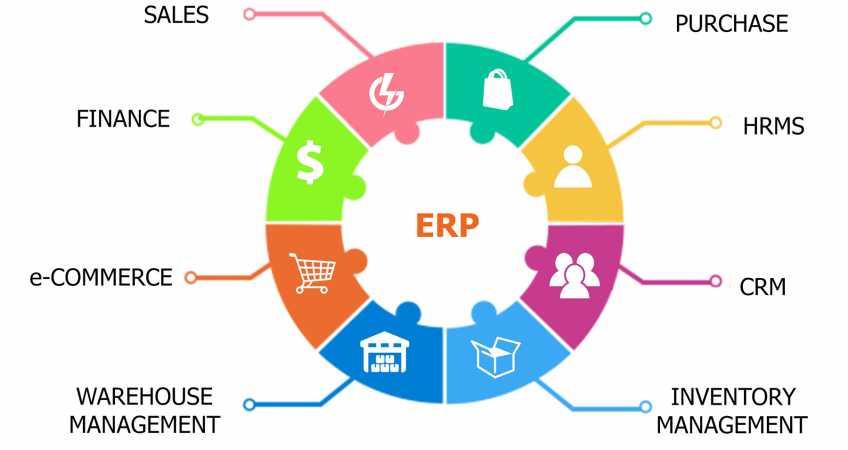
ERP For Business
Business ERPÂ Software
The major goal of ERP is to increase operating efficiency by improving business processes and decreasing costs. ERP allows different departments with diverse needs to communicate with each other by sharing the same information in a single system. ERP thus increases cooperation and interaction between all business units in an organization on this basis.
Also, ERP standardizes processes and data within an organization with best practices. The company also streamlines data flow between different parts of a business by creating a one-transaction system . As Hitt, Wu, and Zhou (2002) stated, “the standardized and integrated ERP software environment provides a degree of interoperability that was difficult and expensive to achieve with stand-alone, custom- built systems.†Standardization and integration of processes and data allows a company to centralize administrative activities, improves ability to deploy new information system functionality, and reduces information system maintenance costs .
As a result of its benefits, ERP has become the backbone of business intelligence for organizations by giving managers an integrated view of business processes . ERP is designed to adapt to new business demands easily. The continuous technological advancement and the increasing complexity of ERP require companies to regularly upgrade their systems. Most ERP vendors provide an opportunity to update procedures and align with perceived best practices to meet changing business needs more quickly
.
Challenges of ERP implementation in Business
In spite of ERP’s significant growth from the late 1990s to the present day, there are a number of challenges that companies may encounter when implementing ERP.
Dillard and Yuthas (2006) stated that most multinational firms are using ERP and that more small and midsize companies have begun to adopt ERP. Despite ERP’s promises to benefit companies and a substantial capital investment, not all ERP implementations have successful outcomes. ERP implementations commonly have delayed an estimated schedule and overrun an initial budget .
Furthermore, the literature indicates that ERP implementations have sometimes failed to achieve the organization’s targets and desired outcomes. Much of the research reported that the failure of ERP implementations was not caused by the ERP software itself, but rather by a high degree of complexity from the massive changes ERP causes in organizations .
These failures can be explained by the fact that ERP implementation forced companies to follow the principle of ‘best practices’ in most successful organizations and form appropriate reference models. According to Helo et al., (2008), “Unlike other information systems, the major problems of ERP implementation are not technologically related issues such as technological complexity, compatibility, standardization, etc. But mostly organization and human related issues like resistance to change, organizational culture, incompatible business processes, project mismanagement, top management commitment, etc.â€. Huang, Chang, Li and Lin (2004) presented the top ten risk factors causing ERP implementation failure .
- Ineffective communications with users.
- Failure to get user support.
- Attempts to build bridges to legacy applications.
- Composition of project team members.
- Misunderstanding of change requirements.
- Lack of senior commitment.
- Insufficient training of end users.
- Lack of effective project management methodology.
- Conflicts between user departments.
- Failure to redesign business process.
These risk factors illustrate various organizational considerations: organization fit, skill mix, project management and control, software system design, user involvement and training, and technology planning.
Since ERP implementation inevitably causes organizational changes, it requires the engagement of senior management from across the organization who is able to resolve conflicts. Without the commitment of senior management, ERP implementation has a high risk of failure.
In other words, due to changes in business processes across an organization, there can be resistance to adopting the ERP system. ERP connects and integrates all business functions within the organization. Therefore, it is critical that management staff be committed, and particularly that they equip employees who are using business functions influenced by ERP with clear channels of communication. Lack of end- user training increases risks by creating confusion and inaccuracy, thereby decreasing user satisfaction and the credibility of the system.
Excellent project management is also needed for successful ERP implementation. Project teams should have clear guidelines to execute ERP implementation from their project objectives and work plan to their resource allocation plan. Without good project management, ERP implementation projects that are large in scale and must take place over longer time periods may end in failure.
Furthermore, the composition of team members plays a crucial role in ERP implementation. ERP integrates diverse business functions across an organization into one single system, necessitating a complex and integrated software package. If a project team does not clearly understand the changes in its organizational structure, strategies, and processes from ERP implementation, it will not be in a position to benefit from ERP’s competitive advantage. In order to best implement ERP, project team members should be selected with a balance between members with business experience within the organization and external experts with specialties in ERP.
However, in ERP implementations, both schedule and cost tend to be underestimated, while scope is overestimated (Aiken, 2002). ERP changes the entire organizational environment by reengineering the entire business process; thus, after implementation, it is not easy to revise previous processes. Therefore, ERP implementations need accurate estimation, preparation with a holistic view, and systematic management of the entire implementation process.
